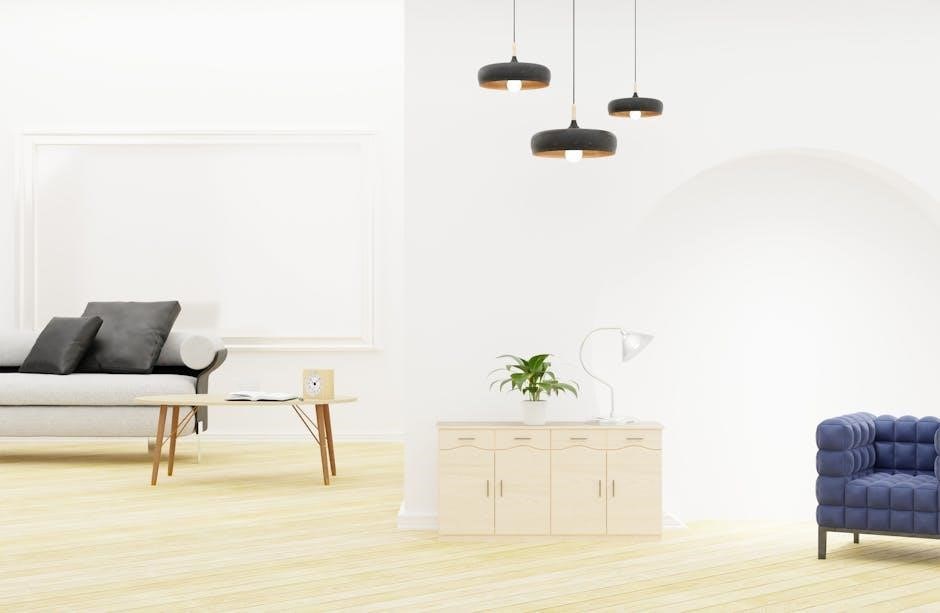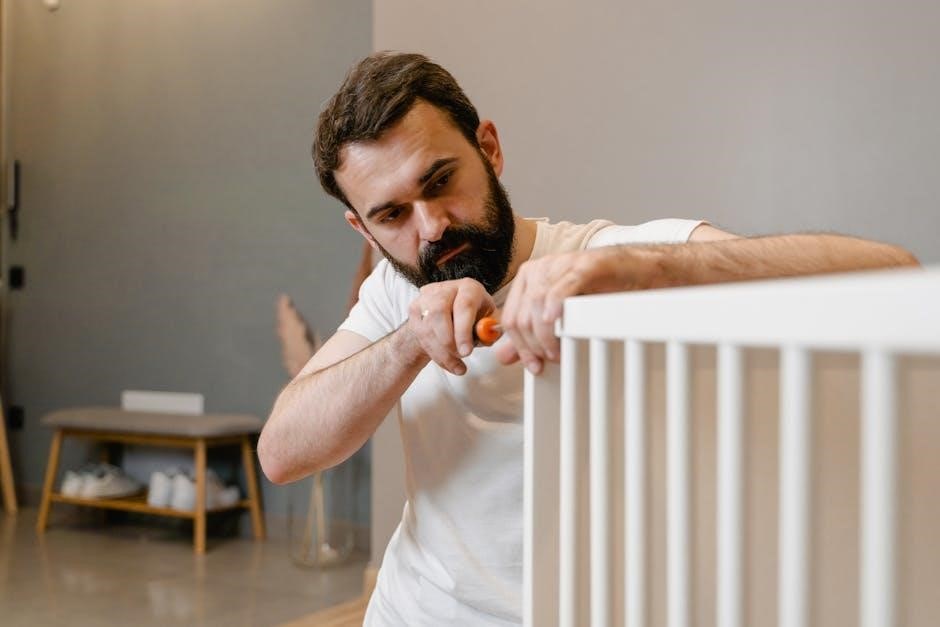Welcome to the comprehensive guide for assembling your Oikiture bed frame. This step-by-step manual will walk you through preparation, tools, and troubleshooting for a seamless experience.
Overview of the Assembly Process
The Oikiture bed frame assembly process is straightforward but requires attention to detail. It involves unpacking, organizing, and systematically assembling various components. Begin by attaching side rails to the headboard and footboard, then connect them to form the base. Next, install support legs and secure the slatted base. If applicable, assemble and attach storage units. Finally, tighten all connections and ensure stability. The process is manageable with patience and proper tool usage, following the manual step-by-step.
Importance of Following Instructions
Following the instructions for assembling the Oikiture bed frame is crucial for ensuring safety, stability, and durability. Misaligned or improperly secured parts can lead to a shaky frame or even collapse. By adhering to the guide, you avoid potential hazards and guarantee a sturdy structure. Proper assembly also preserves the product’s warranty and maintains its aesthetic appeal. Take your time to follow each step carefully, as shortcuts may compromise the final result. This attention to detail ensures a safe and enjoyable experience with your new bed frame.

Preparing for Assembly
Before starting, ensure all components and tools are ready; Clear a large, flat workspace and gather the instruction manual. Plan the assembly sequence.
Gathering Tools and Materials
Start by collecting all necessary tools and materials. Typically, you’ll need an Allen wrench, screwdriver, and bolts. Check the manual for specific tools required. Ensure all hardware like screws, washers, and brackets is accounted for. Organize components to avoid confusion. Verify the bed frame kit includes everything listed. Having everything ready saves time and prevents delays. Keep tools within reach to streamline the process. Double-checking ensures no missing parts, allowing assembly to proceed smoothly.
Setting Up the Workspace
Choose a large, flat, and stable area for assembly. Clear the floor of clutter to avoid tripping hazards. Lay down a soft cloth or mat to protect the bed frame components from scratches. Position the bed frame in the center of the room for easy access. Ensure good lighting to see small parts clearly. Keep tools and hardware within reach to save time. A clean, organized workspace reduces errors and speeds up the assembly process. Ensure the area is safe from distractions, like children or pets, to maintain focus.
Understanding the Hardware Provided
Familiarize yourself with the hardware included in the Oikiture bed frame kit. Common items include bolts, screws, dowels, and Allen keys. Each piece serves a specific purpose, such as securing the frame or attaching slats. Refer to the instruction manual for a detailed list and diagrams. Count and organize the hardware to ensure all parts are included. Misplacing or misidentifying hardware can delay assembly. Understanding each component’s role helps streamline the process and ensures a secure, stable structure; Proper hardware usage is essential for safety and durability.

Unpacking and Inventory
Begin by carefully unpacking the bed frame box to avoid damaging any components. Inside, you’ll find the frame pieces, slats, screws, and an instruction manual. Check for completeness by comparing the contents with the manual’s inventory list. Ensure no parts are missing or damaged before proceeding. This step is crucial for a smooth assembly process and to avoid delays. Organize the components neatly for easy access during assembly.
Checking All Components
Thoroughly inspect each part for damage or defects. Count and verify all major components, such as side rails, slats, and support legs, against the manual’s inventory list. Ensure all hardware, including bolts, screws, and allen keys, is included and undamaged. Check for any signs of wear or manufacturing defects. If any part is missing or damaged, contact customer support immediately. Organizing the components by type will help streamline the assembly process and prevent confusion later on. Accuracy here ensures a trouble-free assembly experience.
Matching Parts with Instruction Manual
Once all components are unpacked, cross-reference each part with the diagrams and labels in the instruction manual. This step ensures every piece is accounted for and correctly identified. Pay attention to labels or codes on the parts that match the manual’s descriptions. If unsure, refer to the exploded view diagrams for clarity. Organizing parts by type or function as you go will save time and reduce confusion during assembly. Patience here ensures accuracy and avoids mismatches later on.
Organizing Parts for Efficiency
Sort and group similar components, like bolts, screws, and brackets, into separate containers for easy access. Use small bins or bags to keep hardware organized by type and size. Label each container to quickly identify contents. Place larger parts, such as side rails or slats, in a designated area away from smaller items. This methodical approach reduces assembly time and minimizes the risk of misplacing essential pieces. A well-organized workspace ensures a smoother and more efficient assembly process.

Assembling the Side Rails
Align side rails with headboard and footboard, ensuring a secure fit. Use provided hardware to tighten connections. Double-check alignment for optimal stability.
Attaching the Side Rails to the Headboard
Align the side rails with the pre-drilled holes on the headboard. Insert the bolts provided into the holes and gently tighten them by hand. Ensure the rails are evenly spaced and flush with the headboard’s edges. Use a wrench or Allen key to secure the bolts firmly, but avoid over-tightening to prevent damage. Double-check the alignment to ensure stability and proper fit. This step is crucial for maintaining the structural integrity of the bed frame.
Securing the Side Rails to the Footboard
Position the side rails against the footboard, aligning the bolt holes. Insert the provided bolts into the pre-drilled holes and hand-tighten them. Use a wrench or Allen key to firmly secure the bolts, ensuring they are tightened evenly. Double-check the alignment to confirm the rails are straight and properly attached. This step ensures the bed frame is sturdy and evenly balanced, preventing any wobbling or instability. Proper securing of the side rails to the footboard is essential for long-term durability and safety.

Building the Bed Frame Structure
Start by aligning the main frame components, then secure them using the provided hardware. Tighten all connections to ensure stability and proper alignment for a sturdy bed structure.
Connecting the Side Rails
To connect the side rails, align them with the pre-drilled holes on the headboard and footboard. Use the provided bolts to secure them firmly. Tighten the bolts in a star pattern to ensure even pressure. Double-check that the rails are level and the frame is balanced. Proper alignment is crucial for the bed’s stability and longevity.
Installing the Support Legs
Position the support legs at the designated points on the bed frame, typically beneath the side rails or slatted base. Align the legs with the pre-drilled holes and secure them using the appropriate screws from the hardware bag. Tighten the screws firmly to ensure stability, but avoid overtightening initially to allow for minor adjustments. Once all legs are in place, tighten them fully to ensure the frame is balanced and sturdy. This step is crucial for preventing wobbling and ensuring the bed remains level and secure.
Ensuring Frame Stability
To ensure the bed frame is stable, start by verifying that all connections are secure and properly tightened. Use a spirit level to check that the frame is evenly balanced and not leaning. If necessary, adjust the support legs to achieve a level surface. Double-check that all bolts and screws are tightened firmly but avoid overtightening, which could damage the frame. Finally, apply gentle pressure to test the stability and make any final adjustments to ensure the bed is rock-solid and safe to use.

Attaching the Slatted Base
Align the slatted base with the frame, ensuring proper fit and alignment. Secure the slats to the side rails using the provided hardware. Tighten evenly.
Aligning the Slats with the Frame
Securing the Slats to the Side Rails
Once the slats are aligned, use the provided bolts and washers to secure them to the side rails. Start by attaching the center slat to ensure balance, then work your way outward. Tighten each bolt firmly, but avoid overtightening to prevent damage. Ensure all slats are evenly secured for consistent support. Use a wrench for added grip while tightening. Double-check that all connections are snug and even to guarantee the slatted base is stable and properly integrated with the frame.
Tightening the Slatted Base
After securing the slats to the side rails, use an Allen wrench to tighten all bolts evenly. Start from the center and work outward to maintain balance. Ensure each bolt is snug but not overtightened, as this could damage the slats or frame. Double-check each connection to confirm stability. Once tightened, inspect the slatted base to ensure it lies flat and aligns perfectly with the frame. Proper tightening ensures optimal support and prevents sagging or shifting over time.

Adding Storage (If Applicable)
If your bed frame includes storage, follow specific instructions for assembling drawers or compartments. Ensure all parts are securely attached to maintain the frame’s stability and functionality. Organize items neatly to maximize space and keep your bedroom clutter-free.
Assembling Storage Drawers
Begin by unpacking all drawer components, including the drawer base, sides, and front panel. Attach wheels or glides to the bottom of the drawer using the provided screws. Next, assemble the drawer frame by aligning the sides with the base and securing them tightly. Attach the front panel to the frame for a finished look; Ensure all connections are sturdy and properly aligned. Finally, install the drawer slides onto the bed frame and insert the drawer to complete the storage unit.
Attaching Storage Units to the Frame
Once the storage drawers are assembled, position them near the bed frame. Locate the pre-drilled holes or attachment points on the frame. Use the provided bolts or brackets to secure the storage unit to the bed. Ensure proper alignment to maintain stability. Tighten all connections firmly but avoid over-tightening. Double-check the unit’s placement and stability before use. Refer to the manual for specific attachment points and hardware requirements to ensure a safe and secure installation.

Finalizing the Assembly
Tighten all connections and ensure the bed frame is stable. Double-check alignment and security of all components. Verify that all parts are properly attached and secure.
Aligning and Tightening All Connections
Ensure all bolts, screws, and brackets are properly aligned before tightening. Use an Allen wrench or screwdriver to secure connections firmly. Double-check each joint to confirm alignment and stability. Tighten all hardware in a systematic order to avoid misalignment. Apply even pressure to prevent stripping screws. Verify that all moving parts operate smoothly and silently. Repeat the tightening process for any components that may have loosened during assembly. This step ensures long-term durability and safety of the bed frame.
Double-Checking for Stability
Gently shake the bed frame to ensure it is stable and does not wobble. Check all connections, especially at the joints, to confirm they are secure. Apply moderate pressure to the center of the frame to test its durability. Ensure the bed sits evenly on the floor and does not tilt. Verify that all support legs are firmly in place and evenly distributed. This step guarantees the bed frame is safe and sturdy for everyday use.
Final Inspection Before Use
Conduct a final inspection to ensure all components are correctly assembled and tightened. Check for any loose screws or bolts that may have been missed. Verify that the slatted base is properly aligned and securely attached to the side rails. Ensure there are no sharp edges or protruding parts that could cause injury. If storage units are present, confirm they are firmly attached and function smoothly. Finally, make sure the bed frame is clean and free of any debris before use.

Tips for a Smooth Assembly
Plan ahead, use the correct tools, and maintain a clean workspace. Follow instructions step-by-step and double-check each part before moving forward for a hassle-free experience.
Using the Right Tools
To ensure a smooth assembly process, gather all necessary tools beforehand. Typically, an Allen wrench, screwdriver, and bolts are provided. Check the toolkit to confirm completeness. Using the correct tools prevents damage to hardware and ensures proper tightening. Optional tools like clamps or a rubber mallet can aid in aligning parts. Always refer to the manual for specific tool recommendations. Proper tools streamline assembly, reducing frustration and ensuring a secure, professional finish.
Following the Manual Closely
Adhering strictly to the assembly manual ensures accuracy and prevents errors. The manual provides a step-by-step guide, complete with diagrams, to help you understand each process. Skipping steps or deviating from instructions can lead to misaligned parts or instability. By following the manual closely, you ensure all components fit together seamlessly. This attention to detail guarantees a sturdy and functional bed frame, avoiding potential issues during or after assembly.
Avoiding Common Mistakes
To ensure a smooth assembly process, avoid common pitfalls like rushing through steps or assuming familiarity with parts. Misaligned pieces or over-tightening bolts can damage components. Always organize parts beforehand to prevent losing or mixing them. Double-checking each step before proceeding helps catch errors early. Avoiding these mistakes saves time and ensures a stable, durable bed frame. Patience and attention to detail are key to a successful assembly experience.

Troubleshooting Common Issues
Identify and resolve common assembly issues, such as misaligned parts or loose connections, by reviewing instructions and ensuring all hardware is correctly secured. This prevents structural weaknesses.
Dealing with Misaligned Parts
If parts don’t align properly, recheck the manual to ensure correct orientation. Disassemble if necessary and retry. Measure components to confirm they match the manual’s specifications; Use shims or adjust angles gently to achieve proper fit. Patience is key to avoid forcing pieces, which may damage the frame. If issues persist, consider consulting online resources or contacting customer support for clarification. Proper alignment is crucial for stability and safety. Double-checking each step can prevent future assembly problems.
Resolving Tightening Problems
If bolts or screws won’t tighten properly, ensure they’re fully seated and aligned with pre-drilled holes. Check for any debris or paint obstructing the hardware. Use a rubber mallet to gently tap pieces into place before tightening. Avoid over-tightening, as this can strip screws or damage wood. If issues persist, consult the manual or contact customer support for replacement hardware. Proper tightening ensures the frame’s stability and longevity, so take time to address any looseness promptly during assembly.
Addressing Stability Concerns
Ensure all legs and support beams are evenly placed and tightly secured. If the frame feels unstable, verify that all bolts and screws are fully tightened and aligned correctly. Check for any wobbling by gently rocking the frame; if it persists, adjust the legs or ensure the floor is level. Proper alignment of slats and side rails also contributes to stability. Double-checking these areas helps prevent structural issues and ensures a safe, durable bed frame.
Congratulations! You’ve successfully assembled your Oikiture bed frame. Take pride in your accomplishment and enjoy the comfort and durability of your newly assembled bed.
Final Thoughts on the Assembly Process
Completing the Oikiture bed frame assembly is a rewarding experience that leaves you with a sense of accomplishment. While the process may seem daunting at first, patience and careful attention to detail ensure a sturdy and comfortable final product. Taking your time to follow each step and double-check your work is key to avoiding frustration. The end result is a well-crafted bed that enhances your bedroom’s aesthetics and provides lasting durability. Enjoy the satisfaction of a job well done and the comfort of your new bed!
Enjoying Your Newly Assembled Bed Frame
Your newly assembled Oikiture bed frame is now ready to enhance your bedroom experience. Take pride in knowing you’ve crafted a sturdy, stylish piece that reflects your effort and dedication. Ensure a comfortable setup by adding your preferred mattress and bedding. Personalize the space with decor that complements the frame’s design. Regularly inspect and tighten connections to maintain stability. With proper care, your bed will remain a cozy and reliable centerpiece for years to come. Relax and enjoy the fruits of your labor!
